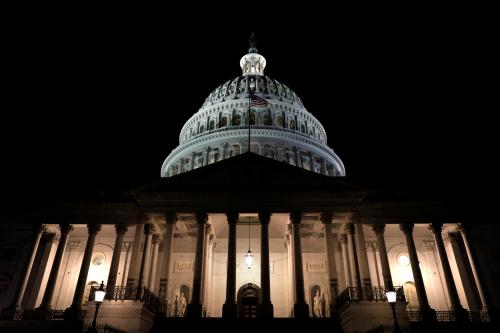A version of this op-ed originally ran in The Hill on October 10, 2019. The late Alice Rivlin passed away in May of 2019 as she was collaborating on this piece with Sheri Rivlin and Allan Rivlin. Alice wrote the first draft of this piece, which Sheri and Allan completed following Alice’s guidance. Sheri and Allan are also working to complete Alice Rivlin’s final manuscript, “Divided We Fall: Why Consensus Matters” due for publication by Brookings Institution Press in 2020.
America was once a country defined by our confident self-perception that we sometimes called “American exceptionalism.” Our “can-do” spirit helped us win two world wars, land on the moon, invent much of the world’s economy, and create a working class that was the envy of the world. Now we wonder whether we are a nation coming apart at the seams.
America is divided in ways that bring to mind the great social upheavals of the 1960s, or worse, our great Civil War of the 1860s. The rise of “red-state” versus “blue-state” hyper-partisanship has metastasized into increased racism, nationalism, anti-Semitism, xenophobia, Islamophobia, and homophobia that is far too often expressed through violent attacks. A truly great nation worthy of a modern exceptionalism would rise to the challenge of healing the wounds of hate and division, giving all Americans the opportunity to participate in growing an economy that offers broadly shared prosperity.
When we look deeply at the political and cultural divisions cleaving America, we consistently find extremes of economic inequality adding fuel to these fires. Stark differences in current economic security and future prospects bring anxiety, fear, distrust, and resentment. High earners in booming cities are able to separate themselves and their families by participating in the globally-connected knowledge economy. While the economically insecure on the city streets below—and in mid-sized cities, small towns, and rural counties in the parts of America that have still not seen a recovery—struggle to pay monthly bills, pay off debt, cover the costs of education, healthcare, and housing, and hold onto hope for a better future.
Economic inequality has two important dimensions—vertical and horizontal —and an economic plan to tackle both dimensions could go a long way toward uniting red-state and blue-state America and breaking the hyper-partisan gridlock in Washington. Democrats understand vertical inequality, which exists in every community, but is most visible in large cities where extremes of wealth and poverty exist in close proximity. Republicans pay more attention to horizontal inequality: differences in wealth, income, and growth between the big cities—mostly on the coasts, and the rest of America in the Heartland where agriculture and manufacturing have been in a long-term decline.

Horizontal inequality exists in every community, with areas of wealth and opportunity separated from areas of poverty and decline, but it is most visible in national maps that show the concentration of the nation’s economic growth in the largest cities (blue in the map above), leaving the mid-sized cities, small towns, and rural counties either stagnating (shown in gray) or in decline (shown in red). Decades of deindustrialization of the American Heartland and unreliable prices for agriculture products have hollowed out small town America, leaving declining populations, falling property values, a diminished tax base, and rising rates of “deaths of despair” including alcoholism, opioids, and suicide.
At the county level, there is a remarkable correlation between economic growth and voting behavior; Democrats are concentrated in the fast-growing cities and Republicans dominate the lower density interior states—small towns and rural counties that make up most of the nation’s land mass but somewhat less than half of the population. A failure by Democrats to appreciate the economic frustration and pain felt in states like Pennsylvania, Ohio, Michigan, Missouri, Iowa, West Virginia, and Wisconsin contributed to Donald Trump’s Electoral College victory in the 2016 presidential election.
With America divided politically and culturally and Washington at a standstill due to hyper-partisan warfare, the 2020 election offers voters a chance to choose a different direction. A national strategy to address vertical and horizontal inequality could appeal to voters in both red and blue states and unite a divided nation around specific plans to grow better paying jobs for the people and places that have been falling behind.
A national strategy to address vertical and horizontal inequality could appeal to voters in both red and blue states and unite a divided nation around specific plans to grow better paying jobs for the people and places that have been falling behind.
Addressing vertical inequality
Political progressives have been drawing attention to vertical inequality for several years and think tanks and political leaders have developed a solid list of proposals designed to shrink the gap between the small number of individuals that have the most and the large number that have the least. Serious proposals to mitigate vertical inequality generally involve increasing the progressivity of the tax code, raising the incomes of the poor through raising the minimum wage and the value of other income supports, and guaranteeing the provision of basic needs such as food, housing, transportation, healthcare, and education for the poor and middle class.
- Tax the rich. The degree to which the political system will support tax increases targeting the income or wealth of the richest Americans will be hotly debated in the 2020 presidential election. But the tax code could be made dramatically more progressive by simply reversing the Trump individual tax cuts to raise marginal rates for higher income taxpayers and closing egregious tax loopholes—including the special tax treatment for carried interest benefiting hedge fund partners, and provisions that help out specific industries such as oil, gas, and real estate development.
- Make work pay. At the other end of the income scale, the Earned Income Tax Credit (EITC) should be expanded and increased. The name of the EITC may be unwieldy, but the policy is effective in providing badly needed additional income for low-paid working families through the tax code. The EITC has enjoyed broad bipartisan support in the past and there likely would be bipartisan support now for increasing its value and including more people.
- Help people afford basic needs. The federal government spends a lot of money to help lower-income individuals and families pay for food, housing, winter heating, and a wide variety of other needs, but proposals to increase the generosity and breadth of these programs receive increased attention during an election cycle. A tax code made dramatically more progressive by increasing top rates and closing loopholes that benefit the wealthy would increase government revenue, funding some of these proposals for new federal spending to help families with college tuition, student loan debt, or health care. It could even provide a guaranteed minimum income. But the same tax revenues cannot be spent several times over and the 2020 federal deficit is projected to surpass a trillion dollars. Difficult choices must be made across the entire federal budget and even among these worthy initiatives to help working families move from barely surviving to thriving in the modern economy.
The best approaches are those that help people get and advance in better paying jobs and raise healthy families with children ready to succeed in school and in life. Rather than just giving people money, it makes more sense to help people afford more education and technical skills training, so they can get a better job. Transportation assistance is also needed in many areas to help people get to where the jobs are. There is a broader societal agenda to raise pay and professional standards for some of the most important but least well-compensated workers in our society: those that take care of the youngest and oldest Americans. Programs that strengthen child-care, preschool, healthcare, and home health assistance, are particularly needed.
- Rewrite the rules. Decades of political dysfunction in Washington have given us laws and regulations that are out-of-date: unable to keep up with massive changes in technology and global markets and skewed to the benefit of the most powerful interests in the industries being regulated. We need to get Washington working again so we can pass up-to-date laws protecting the health, safety, and welfare of the public as consumers, workers, borrowers, investors, and neighbors of American businesses. Antitrust laws to check monopoly power, strengthened labor and worker health and safety laws, environmental laws, and continuous improvement in financial and credit market regulation, are all needed to protect us from crisis and catastrophe. And we need to export our values by negotiating trade deals that protect the environment, health, safety, and incomes of workers in our trading partners.
Addressing horizontal inequality
Republicans have been more consistent in highlighting the pain and resentment in the deindustrializing heartland and rural areas where there has been no economic recovery. Their principal policy, however, including Opportunity Zones in the 2017 Tax Bill, is not an adequate response to the problem. If well administered by state and local governments, lower taxes in Opportunity Zones could encourage projects that benefit struggling families in economically challenged communities, but there is an equal danger that this is just a method for lowering taxes for developers who are gentrifying those areas. A new national economic strategy in the form of a collaboration between federal, state, and local government to prioritize public and private investments to bring better paying jobs to the parts of America that have been falling behind, is needed and could gain widespread voter support.
A new national economic strategy does not necessarily mean greater power in Washington vis a vis state and local governments. In fact, it should mean a new relationship of greater balance between the federal government and local leaders in the states and cities. Washington has been criticized for many years, and rightly so, for the failure of our national leaders to offer a coherent economic plan, but the same cannot be said of many governors and mayors in big cities and small towns across America. Washington can do more to support regional economic planning, spread successful strategies to more areas, and develop a strategic approach to investing for American global competitiveness in the emerging industries of the coming decades.
While Washington has been incapacitated by vicious hyper-partisan warfare (blame the Hastert Rule) many states and dozens of cities across the country realize they cannot wait for a cavalry to come riding over the hill—they must save themselves with local economic planning and coordination. They have been bringing together local leaders; Republicans and Democrats, businesses and labor groups, have been putting aside their differences to develop strategies to invest in education, innovation, infrastructure, and community quality of life, and to attract new businesses, grow local businesses, and create better paying jobs. Many of these collaborative, regional, economic development efforts are starting to gain traction and show measurable success.
Political leaders in Washington would be wise to study the success of governors and mayors in cities like Cleveland, Pittsburgh, Nashville and Atlanta (although problems and inequality persists in all these examples), as well as the many next-level towns that are seeking to follow their path to success. From Pittsburgh, Erie, and Lancaster, Pennsylvania; to Youngstown, Akron and Dayton, Ohio; to Knoxville and Chattanooga, Tennessee; to Dubuque, Iowa; and Huntington, West Virginia, local leaders are collaborating on the development of regional economic plans, identifying local resources and competitive advantages, and the challenges to be overcome. An economic strategy sets priorities for long-term investments that are made by combining federal, state, and local funding streams with business investment, foundation grants, and non-profit initiatives. Looking at these local plans we see investments in four broad areas: education, innovation, infrastructure, and healthy communities.
- Invest in education and job skills training. Pay teachers more and modernize and support public schools, vocational education, community colleges, job training academies, and apprenticeships, so every American has access to the skills needed for better jobs in the modern economy.
- Invest in innovation. Identify regional strengths and weaknesses, support innovation communities and business start-up incubators, build bridges between businesses and researchers at local colleges and universities, and make investments to create the conditions for local businesses to thrive in future growth areas such as regenerative agriculture, advanced manufacturing, sustainable energy, and knowledge-based industries.
- Invest in Infrastructure. Repair and modernize roads, bridges, rails, airports, seaports, smart energy grids, broadband data networks, and other critical infrastructure, and invest in public transportation so people can get to work, businesses can get materials, get their finished products to customers, and knowledge businesses can connect to customers all over the world.
- Invest in healthy communities. Rebuild downtown areas and Main Streets, Riverwalks, and other common areas with better lighting and community policing so people feel safe and business can grow. Invest in areas of persistent poverty, renovating abandoned buildings, turning vacant lots into parks and playgrounds, and revitalizing libraries, community centers, and senior centers. Support local and regional hospitals and wellness centers and bring healthy food to “food deserts” to sustain a healthy, vibrant population needed to attract the kinds of jobs that offer better pay, opportunity, and economic security.
The key to success is commitment to both comprehensiveness and scale. Just as crops need seed, water, sunlight, and fertilizer—and will fail for lack of any one—all four of these investments: education, innovation, infrastructure, and healthy communities, are necessary for success. Job training without economic development is futile, but development without bringing up the skill-level of the local population is merely gentrification, as the local population will get priced out of the region.
Raising this regional economic development strategy up to the national level would involve 1) strengthening the federal government’s support for these local initiatives to the greatest degree possible, 2) using federal resources as a carrot to encourage more regional collaboration and strategic economic planning in more cities and towns across the country, and 3) using the same approach to strategic economic planning to strengthen America’s competitiveness in the emerging global economic battlegrounds of the future—including renewable energy, electric and self-driving vehicles, sustainable agriculture, advanced manufacturing, robotics, artificial intelligence, and fifth generation telecommunications (5G).
While other countries have been developing five-year, ten-year, and longer-term plans to gain advantage in these industries, Washington has been gripped by hyper-partisan warfare and policy paralysis, rendering once simple tasks like passing a federal budget without a Continuing Resolution difficult and a national infrastructure bill unachieved. The 2020 election will give voters a chance to elect leaders who have the vision to chart a better, smarter economic course forward.
We cannot be united states if we have separate economies, with wealthy elites living in penthouses high above struggling streets, or coastal states surging ahead and interior states falling behind.
We cannot be united states if we have separate economies, with wealthy elites living in penthouses high above struggling streets, or coastal states surging ahead and interior states falling behind. America needs to find a leader who can unite the nation around a plan for economic growth that spreads outside of the cities and includes everyone. Economists call efforts to address vertical inequality “people-based” policies and efforts to address horizontal inequality “place-based” policies. A new national economic strategy combining both approaches would have broad support and would bring greater inclusiveness and opportunity to the people and places in America that have been falling behind.
In a divided government, if new policy is possible at all, it often arrives as a patchwork of policy ideas designed to meet the competing priorities of different interests and political philosophies. It is rare, but possible, to reach a reasoned strategic approach based on a real exchange of ideas in a spirit of compromise and common purpose. This has not been happening often in Washington recently, but it is happening in local regions throughout America. In 2020, America can elect a leader who can heal a divided nation and unite the country around a new economic vision.
The authors did not receive financial support from any firm or person for this article or from any firm or person with a financial or political interest in this article. None of the authors is currently an officer, director, or board member of any organization with a financial or political interest in this article.









Commentary
Op-edTo unite a divided nation, we must tackle both vertical and horizontal inequality
November 5, 2019